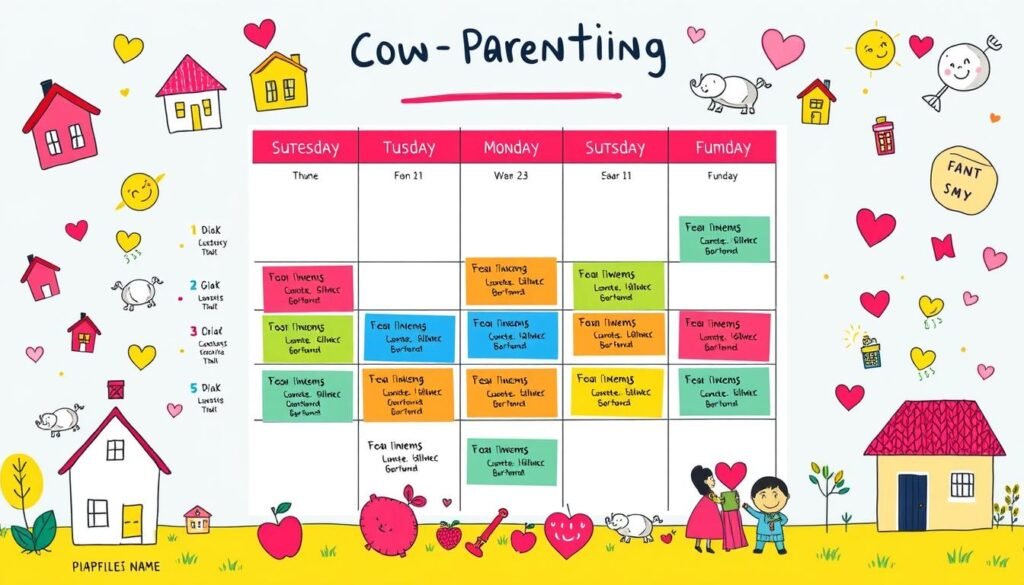Are you curious about parenting plans and co-parenting? A parenting plan is an agreement between parents. It outlines how they will share childcare duties and make decisions for their child. It includes a schedule and agreement on custody.
Research shows 75% of parents miss important details in their plans1. This includes arrangements for other family members and backup childcare. A good plan covers daily care, education, health, and finances. This is key to a successful parenting plan.
When thinking about parenting plans, remember that parents often attend 70% of their child’s events1. This shows how important it is to communicate and plan together. A clear custody agreement in your plan helps both parents know their roles.
Key Takeaways
- A parenting plan is a written agreement between parents that outlines how they will share responsibilities and make decisions for their child.
- A good plan should include all childcare aspects, like daily routines, education, health, and money matters, which is vital for a successful parenting plan.
- Research shows that 75% of parents overlook important details in their plans, such as arrangements for other family members and backup childcare1.
- A co-parenting schedule should be part of the plan to ensure both parents understand their roles and responsibilities.
- A child custody agreement is a key part of a parenting plan. It helps avoid conflicts and ensures the child’s well-being.
- Creating a detailed parenting plan can help reduce conflicts between co-parents and prevent disagreements from getting worse2.
What is a Parenting Plan: Your Complete Guide to Co-Parenting Success
Co-parenting can be complex, but a good parenting plan is key. It ensures your child’s well-being and stability. A parenting plan, or legal parenting plan, outlines custody, visitation, and decision-making roles. About 50% of divorcing couples in the U.S. disagree on child custody, showing the plan’s importance3.
A shared parenting plan helps you and your co-parent make decisions together. This includes education, healthcare, and activities. Only 28% of parents strictly follow the court’s parenting schedule, highlighting the need for clear plans3. Studies show that 50/50 custody is best for kids, leading to better emotional and psychological health3.
When making a parenting plan, think about holiday schedules. About 75% of plans include these details3. Online resources, like the Los Angeles Superior Court’s guides, can help you start4.
A good parenting time arrangement helps you and your co-parent make decisions together. It’s important to update your plan as your child grows. About 80% of parents agree to review their plan yearly to meet their child’s changing needs3.
The Building Blocks of an Effective Parenting Agreement
Creating a parenting plan means thinking about what your child and family need. A parenting plan template can help, but make sure it fits your family. By following parenting plan guidelines, your plan will be complete and work well5.
Good communication is key to a great parenting plan. Talk often about your child’s life and listen to each other’s thoughts. This way, you avoid fights and work better together5.
There are many parenting schedules, like the alternate weekend plan for non-custodial parents6. You might also consider the Standard or Equal Timeshare plans. Choose one that lets your child see both parents often6.
The secret to a good parenting plan is being flexible and cooperative. By focusing on your child’s happiness, you can make a loving home. Always check and update your plan to keep it working well5.
Mapping Out Your Custody Schedule: Time Management Made Simple
Creating a co-parenting schedule is key for both parents and their child. A good child custody agreement helps avoid conflicts and meets the child’s needs. Think about the child’s age, school, and activities when planning7.
There are several ways to balance visitation. You can alternate weeks or use a 4-3 schedule. This means the child spends 4 days with one parent and 3 with the other7. Another choice is the 2-2-5-5 schedule, where the child has 2 days with each parent, then 5 days with each7.
About 50% of family courts suggest a 50/50 time split for parenting schedules8.
Some common 50/50 parenting schedule variations include:
- Biweekly rotation: One week with each parent8.
- 2-2-5-5 rotation: Two days with each parent, followed by five days with each parent8.
Remember to be flexible with your schedule, considering work and holidays7. Parenting schedules can change as the child grows8.
Decision-Making Rights and Responsibilities in Your Plan

Creating a legal parenting plan means thinking about who makes decisions for your child. A shared parenting plan should cover how parents will decide on education, healthcare, and activities9. The parenting plan guidelines suggest setting up a way to make decisions and solve disagreements.
A good parenting plan should have rules for making choices, like who decides on education and healthcare10. Usually, both parents have a say in big decisions like health, education, and religion10. Here are some important things to think about:
- Education: Who picks the school and activities?
- Healthcare: Who decides on medical care and shots?
- Extracurricular activities: Who chooses sports and hobbies?
Clear rules for making decisions help ensure your child’s needs are met. It also makes sure both parents are involved9. Remember, the parenting plan guidelines play a big role in these decisions10.
Financial Arrangements and Child Support Considerations
Creating a parenting plan means thinking about money and child support. A template can help outline who pays for what, ensuring both parents help raise the child11. About half of U.S. kids will see their parents split up before they grow up11.
In joint custody, about 70% of parents stay close after splitting up11. A co-parenting schedule in your plan can help manage costs and expenses12. This includes child support, childcare, activities, medical bills, and school fees12.
As kids grow, their needs change, so your plan should too12. Having a way to solve disagreements, like mediation, is smart12. This way, your plan will always meet your child’s needs and help you co-parent well.
- Child support: In the U.S., it’s about $500 a month on average11.
- Childcare costs: Half of custodial parents get all the child support they’re owed11.
- Extracurricular activities: 40% of parents focus on these activities in their plans11.
By thinking about these points and making a good parenting plan, you can keep your child stable and happy12.
Communication Guidelines: Keeping Everyone on the Same Page
When creating a parenting plan, it’s key to have clear communication rules. This ensures both parents are in sync. Setting up weekly check-ins can boost communication between co-parents13. Using the BIFF method (Brief, Informative, Friendly, and Firm) keeps talks constructive13.
A shared parenting plan with regular family meetings can help kids during a divorce13.
Good communication rules help parents focus on their kids and reduce fights13. About 70% of parents say good communication makes co-parenting better14. Regular meetings can cut down on fights by 40%, making co-parents happier15.
By following parenting plan guidelines, co-parents can make a plan that encourages healthy talking and working together.
Some effective communication tips include:
- Setting up rewards for family meetings
- Using “I statements” to avoid defensiveness
- Planning topics to manage emotions
By using these tips and following parenting plan guidelines, co-parents can make a shared parenting plan. This plan supports their kids’ well-being and helps them work well together14.
| Strategy | Benefit |
|---|---|
| Regular communication check-ins | Reduce conflict by up to 40% |
| Using “I statements” | Lower defensiveness and enhance conversation productivity |
Modification and Review Procedures
Having a legal parenting plan is key. It should be flexible enough to change as needed. A parenting plan template can help start this process. Changes are often made when a parent’s job or living situation changes, which happens in about 60% of cases16.
Courts look at what’s best for the child when they review these changes. In some places, kids can pick which parent to live with when they turn 14, like in Georgia16.
How to change a parenting plan varies by state. Some states, like Virginia, have a six-month wait before considering changes16. Others, like Illinois, have a two-year wait16. About half of disputes are solved through mediation16.
To change a parenting plan, parents need to show evidence, like custody journals or police reports17. In Texas, there must be a significant change after the last order, and there’s a one-year wait before proposing changes17. Knowing how to modify a parenting plan helps parents keep their plan up-to-date. A parenting plan template can guide them to ensure their legal plan is thorough.
Common Pitfalls to Avoid in Your Parenting Plan

Creating a parenting plan can be tricky. It’s important to avoid common mistakes that might cause conflicts. A good co-parenting schedule can help prevent future issues18. Yet, 50% of divorced parents face problems because of bad parenting plans18.
To steer clear of these issues, make sure your child custody agreement includes:
- Clear guidelines for communication and decision-making
- A detailed co-parenting schedule, including visitation arrangements and holiday planning
- Provisions for financial support, including child care costs and health insurance premiums
Guidelines for your parenting plan should also cover how to handle disagreements. This way, you can make a plan that works for both parents and kids. Research shows that plans with clear rules lead to fewer fights19.
Being flexible in your plan is also key. A flexible schedule can adapt to life’s changes and lower conflict20. By focusing on communication and your child’s needs, you can make a plan that everyone agrees on20.
| Parenting Plan Element | Importance |
|---|---|
| Clear Communication Guidelines | High |
| Detailed Co-Parenting Schedule | High |
| Financial Support Provisions | Medium |
Tools and Resources for Creating Your Perfect Plan
Creating a parenting plan needs the right tools and resources. A parenting plan template is a good start, giving you a base to work from. You can find many templates online, like those from Custody X Change, which you can customize for your family21. Family courts often suggest a 50/50 time split, which can be set up in different ways22.
A shared parenting plan can save on legal costs because parents make decisions together21. To make a good plan, focus on these key points:
- Communication guidelines
- Decision-making responsibilities
- Custody schedules
- Financial arrangements
These elements help you make a plan that suits your child and family. Keeping a good co-parenting relationship is key for your child’s emotional well-being22.
Online tools, like parenting plan software, can also help. They offer features for scheduling, talking, and tracking expenses, making co-parenting easier. Pick a tool that fits your needs, aiming for a parenting plan that supports a stable, loving home for your child21.
With these tools and resources, you can make a shared parenting plan that suits your family. Be open to changing your plan as your child grows, ensuring it always meets their needs22.
| Tool/Resource | Description |
|---|---|
| Custody X Change | Parenting plan template and software |
| Online parenting plan resources | Guides, tutorials, and support for creating a parenting plan |
| Co-parenting apps | Tools for scheduling, communication, and expense tracking |
Conclusion: Empowering Your Family Through Thoughtful Planning
Creating a good parenting plan is key for families dealing with co-parenting. It helps make a clear co-parenting schedule and parenting time plan. This way, your family can make smart choices, lower conflict, and keep a stable home for your kids23.
A good parenting plan is more than a legal paper. It’s a guide to success. By using the advice in this article, you can make a plan that suits everyone. This promotes open talk, respect for each other, and puts your kids first24.
Face co-parenting challenges with a positive spirit. Always remember the importance of patience, understanding, and humor. With careful planning and a focus on your family’s happiness, you can overcome the challenges of blended families. You’ll make memories that bring you closer together23.
FAQ
What is a parenting plan?
Why do I need a parenting plan?
What are the core components of a parenting plan?
How do I create a balanced custody schedule?
How do I handle decision-making in my parenting plan?
What should I consider when it comes to financial arrangements?
How can I ensure effective communication in my parenting plan?
When and how can I modify my parenting plan?
What are some common pitfalls to avoid in my parenting plan?
What tools and resources are available to help me create a parenting plan?
Source Links
- Everything You Need to Know About Parenting Plan Elements: Free Checklist Included – https://www.ourfamilywizard.com/blog/checklist-writing-parenting-plan
- The Essentials of a Successful Parenting Plan – https://www.psychologytoday.com/intl/blog/better-divorce/202010/the-essentials-successful-parenting-plan
- Parenting Plan Checklist for Mediation & Co-parenting – https://www.custodyxchange.com/topics/plans/overview/parenting-plan-checklist.php
- Resources to develop a parenting plan | California Courts – https://selfhelp.courts.ca.gov/resources-develop-parenting-plan
- PDF – https://www.texasattorneygeneral.gov/sites/default/files/files/child-support/Parenting Together/coparenting.pdf
- What should be included in a parenting plan? – https://memphisdivorce.com/tennessee-parenting-plan-law/what-should-be-included-in-a-parenting-plan/
- Ohio Parenting Time Guidelines | OH Custody Schedules – https://www.custodyxchange.com/locations/usa/ohio/parenting-time-schedule.php
- Creating a Perfect Parenting Plan in 6 Steps – https://www.ourfamilywizard.com/blog/creating-perfect-parenting-plan-6-steps
- Parenting Plan | The Maryland People’s Law Library – https://www.peoples-law.org/parenting-plan
- Issues To Consider When Creating A Parenting Plan – Updated Jun 2024 – https://www.mcconnellfamilylaw.com/checklist-couples-children-important-issues-consider-creating-parenting-plan/
- How to Make Your Parenting Plan: Create Yours in Minutes – https://www.custodyxchange.com/topics/plans/overview/parenting-plan.php
- Association of Family and Conciliation Courts > Resource Center > Family Resources > A Guide for Joint Custody and Shared Parenting – https://www.afccnet.org/Resource-Center/Family-Resources/A-Guide-for-Joint-Custody-and-Shared-Parenting
- How To Get On the Same Page as Your Co-Parent – By Parent Team – https://www.parentteam.com/post/how-to-get-on-the-same-page-as-your-co-parent
- A Comprehensive Parenting Plan Checklist for Peaceful Co-Parenting – https://freedmarcroft.com/a-comprehensive-parenting-plan-checklist-for-peaceful-co-parenting/
- 07. Getting on the same page as your partner in parenting – https://drsarahbren.com/7-getting-on-the-same-page-as-your-partner-in-parenting/
- Modifying Your Parenting Plan, Schedule or Child Support: 2 Ways – https://www.custodyxchange.com/topics/custody/steps/modify.php
- What to Know Before Modifying Your Parenting Plan – https://www.ourfamilywizard.com/blog/what-know-modifying-your-parenting-plan
- 7 Often Overlooked Provisions to Include in Your Parenting Plan – https://www.custodyxchange.com/topics/plans/provisions/7-overlooked-provisions.php
- Top 5 Child Custody Mistakes to Avoid | Attorney Preston Day – https://www.prestondaylaw.com/blog/top-5-child-custody-mistakes-to-avoid/
- 10 Things Parents Forget To Include In Their Parenting Plans – https://www.chmlaw.com/forget-in-parenting-plan/
- Making Shared Parenting Plans Work For Your Family – https://www.custodyxchange.com/topics/plans/overview/shared-parenting-plan.php
- Creating a Perfect Parenting Plan in 6 Steps – https://www.ourfamilywizard.ca/blog/creating-perfect-parenting-plan-6-steps
- My Key to Successful Co-Parenting Is Not – https://www.greatlakesdfs.com/blog/co-parenting-success
- 5 Heartwarming Ways to Strengthen Your Bond with Your Child During Divorce – https://www.burdinelawfirm.com/talking-to-children-about-divorce-nashville-tennessee/








0 responses to “What is a Parenting Plan? Understand the Basics”